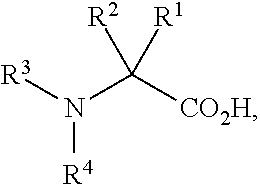Silicon polishing compositions with high rate and low defectivity
a technology of polishing composition and high rate, which is applied in the direction of manufacturing tools, other chemical processes, chemistry apparatus and processes, etc., can solve the problems of undesirable use of amine additives, increase of particle defects and haze on the substrate, and amine use in polishing slurries, etc., and achieve low particle defectivity, low haze, and high removal rate
- Summary
- Abstract
- Description
- Claims
- Application Information
AI Technical Summary
Benefits of technology
Problems solved by technology
Method used
Image
Examples
example 1
[0091]This example demonstrates that polishing compositions of the invention, which comprise silica, an organic carboxylic acid, a polysaccharide, a base, optionally a surfactant, and water, can exhibit good overall substrate polishing properties.
[0092]Silicon substrates were polished using a SURFIN™ 000 pad commercially available from Fujimi Corporation under the same conditions with 6 different polishing compositions identified as Polishing Compositions 1A-1F. Each of Polishing Compositions 1A-1F contained (a) 0.2 wt. % Fuso PL2 silica particles, at point of use, (b) the organic carboxylic acid TA or MA in the concentration set forth in Table 1, (c) the polysaccharide HEC (MW=80,000 g / mol) or XG in the concentration set forth in Table 1, (d) sufficient potassium hydroxide to provide each polishing composition with a pH as set forth in Table 1, and (e) water. In addition, Polishing Composition 1F contained a surfactant, namely SURFYNOL™ 104.
[0093]Similar silicon substrates were pol...
example 2
[0096]This example demonstrates the effect of the organic carboxylic acid and polysaccharide concentrations on substrate removal rate, defectivity, and haze of polishing compositions of the invention.
[0097]Similar silicon substrates were polished using a SURFIN™ 000 pad commercially available from Fujimi Corporation under the same conditions with 6 different polishing compositions identified as Polishing Compositions 2A-2F. Each of the polishing compositions contained (a) 4 wt. % Fuso PL2 silica particles, (b) the organic carboxylic acid MA in the concentration set forth in Table 2, (c) the polysaccharide HEC (MW=80,000 g / mol) in the concentration set forth in Table 2, (d) sufficient potassium hydroxide to provide each polishing composition with a pH as set forth in Table 2, and (e) water.
[0098]The substrate removal rate (RR), defectivity (both DCN and DCO), and haze (DNN) were determined for each polishing composition, and the results are summarized in Table 2. For ease of comparis...
example 3
[0100]This example demonstrates that polishing compositions of the invention, which comprise silica, an organic carboxylic acid, a polysaccharide, a base, optionally a surfactant, and water, exhibit good polishing properties.
[0101]Similar silicon substrates were polished using a SURFIN™ 000 pad, commercially available from Fujimi Corporation, under the same conditions with two polishing compositions identified as Polishing Compositions 3A and 3B, which contained (a) either 4% colloidal silica that has been surface modified with organic agents (Fuso PL2; 52 nm diameter) or a fumed silica (Cabot L90; 90 m2 / g surface area), (b) 5547 ppm malonic acid, (c) 607 ppm HEC (MW=80,000 g / mol), (d) potassium hydroxide, and (e) water.
[0102]The substrate removal rate (RR), defectivity (both DCN and DCO), and haze (DNN) were determined for each polishing composition, and the results are summarized in Table 3.
TABLE 3DNNRRDCNDCOHazeComp.Silica(Å / min)(counts)(counts)(ppm)3Acolloidal145212498690.0843Bf...
PUM
| Property | Measurement | Unit |
|---|---|---|
| haze | aaaaa | aaaaa |
| haze | aaaaa | aaaaa |
| haze | aaaaa | aaaaa |
Abstract
Description
Claims
Application Information
 Login to View More
Login to View More - R&D
- Intellectual Property
- Life Sciences
- Materials
- Tech Scout
- Unparalleled Data Quality
- Higher Quality Content
- 60% Fewer Hallucinations
Browse by: Latest US Patents, China's latest patents, Technical Efficacy Thesaurus, Application Domain, Technology Topic, Popular Technical Reports.
© 2025 PatSnap. All rights reserved.Legal|Privacy policy|Modern Slavery Act Transparency Statement|Sitemap|About US| Contact US: help@patsnap.com



